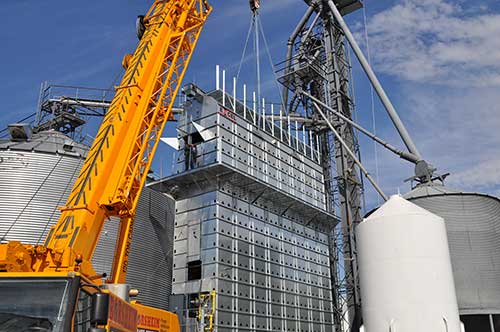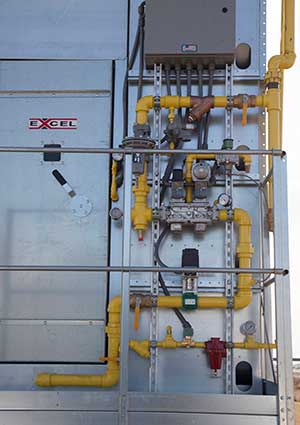
Find a Grain Dryer that Best Suits Your Operation
With grain prices so low, cost-cutting measures take higher priority than usual. What can be trimmed or eliminated? What can be done more efficiently? Grain dryers are a good place to start trimming because they can pull a lot of unnecessary energy.
Selecting a new grain dryer may be the answer to significantly reducing the farm's fuel consumption - and keeping the energy budget in the green.

Thorough research helps determine which dryer will best suit each operation long before pouring a concrete pad. Consider grain quality, energy efficiency, minimal maintenance, easy expansion capabilities and safety features, which all contribute to one objective - reaching the highest return on investment.
DRYER DESIGN: MIX IT UP OR CROSS IT OVER?
Growers tend to rely on one of two dryer designs in an effort to consistently dry their grain for the highest bushel payment. Cross-flow dryers are the most widely used continuous flow dryers. Typically found in a tower dryer, this drying method uses a central heating chamber in the middle of the unit, and the grain fills in around the burner. Its high temperatures work to dry grain quickly by forcing the hot air through the grain from the inside out. While effective at drying grain quickly, tower dryers tend to be less consistent due to the heating design, with kernels near the heater becoming overdried, and those near the wall being underdried.
In contrast, mixed-flow dryers heat grain more slowly, but at equal, consistent rates that reduce the potential for stress cracking. Heat is pushed through alternating rows of heat and exhaust ducts, conditioning the grain from both sides to keep it the same temperature throughout the process. The consistent, tempered heat from the under fans ensures that grain isn't underdried or overdried.

POWER DOWN ENERGY COSTS
Beyond considering time and grain quality, fuel efficiency plays a key role in getting the best ROI. For example, continuous mixed-flow dryers require significantly less energy to operate than a tower dryer, but generally have a higher price tag up front. Growers will notice a faster return on investment with the mixed-flow dryer, which is 10 to 20 percent better than a cross-flow tower dryer for fuel efficiency, according to the Farmstead Energy Audit by the North Dakota State University Extension Service.
Another thing for growers to consider when choosing the best dryer for a strong ROI is the various farm grants available. Programs, such as Rural Energy for America Program with the USDA Rural Development, can offset initial dryer costs by as much as 25 to 40 percent. Work with the equipment dealer, manufacturer or local USDA office to learn more about the eligibility options. Ideal candidates are those who have struggled with worn out or inefficient equipment. Typically, this requires completing an energy audit, which includes gathering statistics on how much energy was saved after switching to a new unit.

PLAN TO BE ON THE GROW
It's also important to not be shortsighted when choosing a new dryer. How many bushels are dried with the current operations, and will the same size dryer fit needs in five years? Consider how easy it may be to expand a dryer as the farm grows.
For a tower dryer, growers can select the model needed and then, months or years later, add modules to dry more grain bushels on the farm. Once ready, this requires purchasing numerous components to complete the expansion. For example, a fan, heater controls and burner must be added in addition to the new modules.
With the mixed-flow dryer, growers can work with the manufacturer to equip the dryer with the motors and electrical components required for the most tiers that would be needed. For example, growers can start with 10 tiers, for a 1,400-bushel capacity, but select the motor and electrical components suited for a 26-tier unit. This significantly reduces the cost and time spent to upgrade the dryer later.
DON'T GET BURNED
Everybody knows how dangerous dryers can be; that's why it's critical to select a dryer with safety features that prevent fires as well as reduce the risk of injury and machine damage. Look for a dryer that features a true-piloted gas train, which prevents the pilot light from reigniting when the main flame goes out, which could cause the dryer to fill with gas and potentially cause an explosion.
Consider also choosing a flame rod rather than a UV sensor for the most accurate flame readings. The flame rod converts energy from the pilot flame into an electrical signal, but UV detectors can misinterpret reflected sunlight as the pilot flame. The false alarm causes the burner to open and the dryer to fill with flammable propane gas. Check with the manufacturer that the dryer also comes equipped with a liquid gas regulator that ensures a dryer's vaporizer doesn't get overloaded with propane, which can foul the air and waste fuel.
Also, look for a dryer manufacturer with a design that specifically prevents hot spots from developing in the unit. The concentrated heat of tower dryers allows fast drying, but it can cause material smoldering. Mixed-flow dryer designs use greater airflow coupled with corner openings to prevent hot spots.
By Rodie Jelleberg, Superior Manufacturing customer service manager
7.22.2015